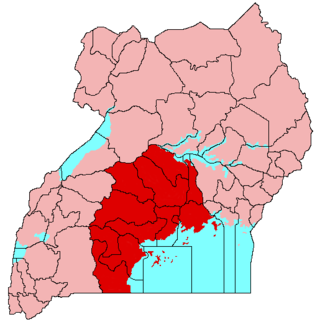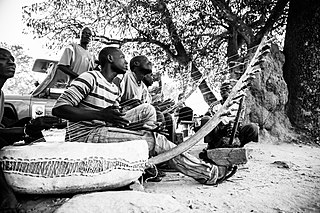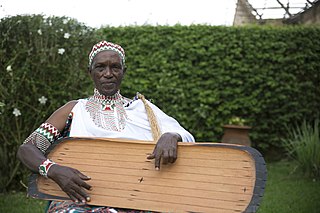
The lyre is a stringed musical instrument that is classified by Hornbostel–Sachs as a member of the lute-family of instruments. In organology, a lyre is considered a yoke lute, since it is a lute in which the strings are attached to a yoke that lies in the same plane as the sound table, and consists of two arms and a crossbar.

Buganda is a Bantu kingdom within Uganda. The kingdom of the Baganda people, Buganda is the largest of the traditional kingdoms in present-day East Africa, consisting of Buganda's Central Region, including the Ugandan capital Kampala. The 14 million Baganda make up the largest Ugandan region, representing approximately 26.6% of Uganda's population.

Uganda, is now ranked number three in Africa as far as music and entertainment is concerned. Uganda is home to over 65 different ethnic groups and tribes, and they form the basis of all indigenous music. The Baganda, being the most musically vibrant nationality in the country, has defined what constitutes culture and music of Uganda over the last two centuries.
Semei Kakungulu was a Ugandan statesman who founded the Abayudaya community in Uganda in 1917. He studied and meditated on the Old Testament, adopted the observance of all Moses' commandments, including circumcision, and suggested this observance for all his followers. The Abayudaya follow Jewish practices and consider themselves Jews despite the absence of Israelite ancestry.

The music of West Africa has a significant history, and its varied sounds reflect the wide range of influences from the area's regions and historical periods.

Ngoma are musical instruments used by certain Bantu populations of Africa. Ngoma is derived from the Kongo word for "drum". Different Bantu-inhabited regions have their own traditions of percussion, with different names for their instruments. In Kikongo, "ngoma" is used by extension to signify specific dances, social occasions, and rhythms. In Swahili, Ngoma music is used to describe music, dance, instruments including the drums, and events together as a joint cultural practice..

In many parts of sub-Saharan Africa, the use of music is not limited to entertainment: it serves a purpose to the local community and helps in the conduct of daily routines. Traditional African music supplies appropriate music and dance for work and for religious ceremonies of birth, naming, rites of passage, marriage and funerals. The beats and sounds of the drum are used in communication as well as in cultural expression.

Baganda music is a music culture developed by the people of Uganda with many features that distinguish African music from other world music traditions. Parts of this musical tradition have been extensively researched and well-documented, with textbooks documenting this research. Therefore, the culture is a useful illustration of general African music.
James K. Makubuya is a Ugandan-born ethnomusicologist, instrumentalist, singer, dancer, and choreographer. He plays several traditional instruments from various parts of Uganda, including the endongo and adungu, endingidi, amadinda, akogo (lamellaphone), and engoma (drums). Makubuya was born in the town of Gayaza, and is a member of the Baganda ethnic group. He holds a B.A. in music and English literature from Makerere University in Kampala, Uganda (1980); a Master of Music degree in Western music and music education from Catholic University of America in Washington D.C. (1988), and a Ph.D. in ethnomusicology from the University of California, Los Angeles (1995).

The endingidi or is a type of bowed string instrument native to Uganda. The endingidi has one string, extending from the neck to a cylindrical sound-box or resonator made of wood or cow horn. A piece of hide is stretched over the top of the cylinder and is fixed to the sound-box with wooden pegs, thorny spines or nowadays also with metal nails. The hide used is usually that of the monitor lizard but also of young goats and sheep or even of the python. The hide is soaked in water for a whole day before being stretched over the sound-box. The neck consists of a straight wooden stick inserted through the walls of the sound-box at about 2 to 3 cm from the top. At the top of the neck a hole is bored at 4 to 6 cm from the end into which a tuning pin is inserted vertically. The string is secured to this pin in such a way that the string can be wound round the pin in a similar way as with a violin. This allows the string to be tightened, so tuning the instrument. The string runs across the sound-box via a bridge and is fixed to the other end of the neck. The string is made of fibre or animal sinew, but nowadays it is more often of nylon. The arched bow consists of a thin flexible twig, to which a string is attached, usually of the same material as the string of the instrument itself. To give the bow more grip on the string of the instrument, resin is rubbed into the bow string. The resin is often attached to the side of the sound-box so the player can easily rub resin on the bow as he plays.

African Harps, particularly arched or "bow" harps, are found in several Sub-Saharan African music traditions, particularly in the north-east. Used from early times in Africa, they resemble the form of harps in ancient Egypt with a vaulted body of wood, parchment faced, and a neck, perpendicular to the resonant face, on which the strings are wound.

The Uganda Museum is located in Kampala, Uganda. It displays and exhibits ethnological, natural-historical and traditional life collections of Uganda's cultural heritage. It was founded in 1908, after Governor George Wilson called for "all articles of interest" on Uganda to be procured. Among the collections in the Uganda Museum are playable musical instruments, hunting equipment, weaponry, archaeology and entomology.

The term African fiddle may be applied to any of several African bowed string instruments.
Yoke lutes, commonly called lyres, are a class of string instruments, subfamily of lutes, indicated with the code 321.2 in the Hornbostel–Sachs classification.

Trough zithers are a group of African stringed instruments or chordophones whose members resemble wooden bowls, pans, platters, or shallow gutters with strings stretched across the opening. A type of zither, the instruments may be quiet, depending upon the shape of the bowl or string-holder. Sound is often amplified with the addition of a gourd resonator. Instruments have been classed into five different types, based on shape.













